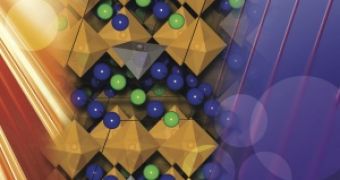Popular wisdom says women have no sense of direction whatsoever. It turns out neither do electrons in solar cells. Hence, researchers must figure out ways to guide them, all for the sake of making it easier and more cost-effective to harvest sun energy and turn it into electricity.
Writing in a recent issue of the journal Nature, researchers with the University of Pennsylvania and Drexel University document the development of a new material, which they say can make solar cells more efficient, easier to manufacture and cheaper.
In their paper, the researchers detail that the solar cells currently in use are made up of two materials. This is because, when exited by light, the electrons in them go haywire and start moving in hectic patterns.
In order for the solar cells to generate power, the electrons must all be moving in the same direction. This is presently achieved by forcing them to cross from one material to another without having any opportunity to go back.
Professor Andrew M. Rappe explains that, several decades ago, the scientific community became aware of the fact that certain materials compel electrons to move in just one direction all by themselves. Until now, this phenomenon has only been demonstrated with UV light.
“There’s a small category of materials, however, that when you shine light on them, the electron takes off in one particular direction without having to cross from one material to another,” the professor explains.
“We call this the ‘bulk’ photovoltaic effect, rather than the 'interface' effect that happens in existing solar cells. This phenomenon has been known since the 1970s, but we don’t make solar cells this way because they have only been demonstrated with ultraviolet light, and most of the energy from the sun is in the visible and infrared spectrum,” he adds.
Should this phenomenon be duplicated with visible light, the green energy industry can only win.
To this end, the University of Pennsylvania and Drexel University researchers have come up with an idea for an innovative new material that would do just that: trick electrons into moving in one direction alone when exposed to visible light.
After several failed attempts, the researchers combined potassium niobate and barium nickel niobate, and created a structure known as a perovskite crystal.
As explained on the official website of the University of Pennsylvania, “Most light absorbing materials have a symmetrical crystal structure, meaning their atoms are arranged in repeating patterns up, down, left, right, front and back. This quality makes those materials non-polar; all directions 'look' the same from the perspective of an electron, so there is no overall direction for them to flow.”
Furthermore, “A perovskite crystal has the same cubic lattice of metal atoms, but inside of each cube is an octahedron of oxygen atoms, and inside each octahedron is another kind of metal atom. The relationship between these two metallic elements can make them move off center, giving directionality to the structure and making it polar.”
The researchers say that, should this material start being used to make solar cells, manufacturing costs would be greatly reduced. What's more, because the electrons would no longer have to wait for their turn to jump from one material to the next, energy loses would also be cut.

 14 DAY TRIAL //
14 DAY TRIAL //